|  
IN THE NEWS | IN THE GARDEN | CALENDAR
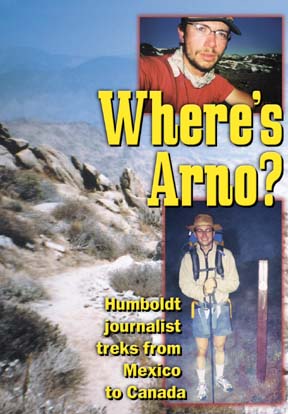
Story & photos by ARNO HOLSCHUH
IT'S SLOW GOING, WALKING ACROSS A SNOWFIELD. Each step forward is a process: I put a foot down, tentatively, making sure the snow's crust will hold my weight, then scout around for my next step, slowly drawing the other foot up and setting it gently down. I can see that I'll be spending a lot of time in the snow today. Snow blankets the valley I'm in, it sits on the peaks around me, coats the frozen lake below me. Everywhere I look is white a blinding, cold, harsh white that reflects up from the slushy ice. I've forgotten my sunglasses and can barely stand the brightness of sunlight reflecting up from the ground beneath me. My feet are soaked with melted snow, my hands are numb from reaching down to steady myself on steep slopes. Snow has become the most important thing in my life, with more power over my happiness than credit card bills, the National League pennant race or anything else I am accustomed to caring about. 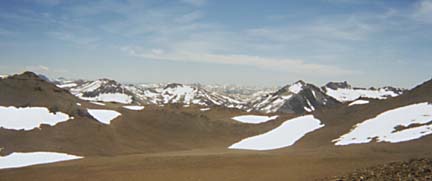
I shouldn't be surprised at the icy conditions; it is late June, but when you're in the High Sierra, the snow often lasts until August. And I am definitely in the High Sierra: I'm approaching Muir Pass, a 12,300-foot-high notch between steep granite monoliths that stretch another thousand feet up on either side. After hours of painstaking work, I finally reach the pass. A new ragged set of peaks stands watch over a new valley, and a new expanse of white awaits me. A low stone hut built by the Sierra Club in the 1930s stands to my left, and I watch idly as a marmot a high-altitude mammal that looks approximately like an overgrown chipmunk comes out of it to greet me. I want to go inside that hut, sit down and take a break, eat a meal, maybe sleep for a couple days, but that's not going to happen. I can't afford to lose any time I still have another 20 miles to hike today. After all, Canada isn't getting any closer with me just standing here. 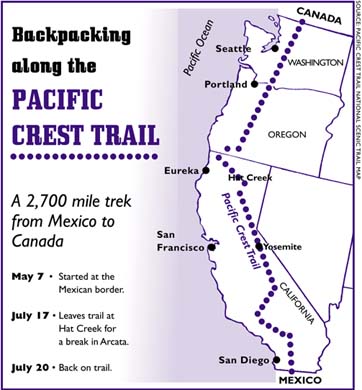 A "thru-hiker" A "thru-hiker"
Canada? No, I'm not on the run from the law or dodging the draft. I'm a "thru-hiker" on the Pacific Crest Trail. A 2,700-mile-long path that runs from Mexico to Canada, the PCT passes through desert, swamp, volcanic wastelands, lush green forests, three states and several distinct mountain ranges. Each year, around 300 people attempt to hike the entire thing. This year I'm among them, rising each day with the sun and falling asleep just after dark some 25 or 30 miles further. Right now, I'm halfway done, having just completed mile 1,300. And believe me, every one of those miles has counted. When you're driving, it's easy to let distance just sort of slip under your wheels. You can make it from Trinidad to Texas in a matter of days and never really notice the land. When you're walking, though, each mile has its own significance, its own challenge and potential for adventure. And adventure comes in spades. It can be cresting a desert ridge just in time to see a coyote melt away into the cactus and scrub right in front of you. It could be hiking at night under a canopy of the brightest stars you've ever seen. Hearing a rattlesnake's unmistakable hiss and clatter may not sound like fun, but it's quite a rush. One morning in late May, I woke up to find a thin layer of frost on my sleeping bag. Even though it was an inauspicious beginning to my day, I had to laugh; I was in the desert and I knew the temperature would be getting into the triple digits by early afternoon. But just then it was nothing but cold, and my light clothing wasn't enough to keep the shivers off my body. I started hiking, hoping to get warm through exertion. After about an hour, my hands still felt like ice cubes and my mood was not improving. Then I saw the hot springs. Tucked away into a little ravine was a group of three hot springs, all of them channeled into little pools for passersby to soak themselves. I scurried down to the springs, nodded hello to the tribe of naked hippies who seemed to pretty much live inside the water, and soaked the lingering memory of that frost right out of my body. Life is full of pleasant surprises on the PCT. Befriending pain 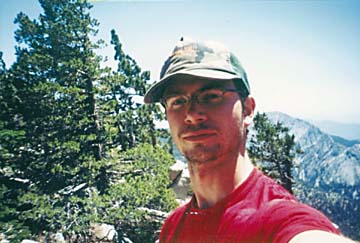 It is well that it is so, for it is also full of pain. The human body is an amazing thing and can adapt to a wide variety of conditions. One thing it was definitely not designed to do, however, is hike 30 miles a day. When you stress your body, it complains, and the language of a body's complaint is pain. You grow closely acquainted with pain; it is not a monolithic sensation, but rather a broad spectrum or palette. There's the incessant sharp biting pain of a blister, the slow ache of a muscle being pushed too hard, the tender sensitivity of a sunburn. It is well that it is so, for it is also full of pain. The human body is an amazing thing and can adapt to a wide variety of conditions. One thing it was definitely not designed to do, however, is hike 30 miles a day. When you stress your body, it complains, and the language of a body's complaint is pain. You grow closely acquainted with pain; it is not a monolithic sensation, but rather a broad spectrum or palette. There's the incessant sharp biting pain of a blister, the slow ache of a muscle being pushed too hard, the tender sensitivity of a sunburn.
But it's amazing what you'll put up with. Blisters are the most obvious example: Everyone gets them, especially at the very beginning of the hike, when you are walking across scalding-hot sands with fresh, soft feet. They become part of your life. I had an angry red spot the size of a quarter on the ball of my left foot that stubbornly refused to heal for a month. I eventually realized that the constant stream of expletives I was directing at the trouble spot didn't seem to be speeding the recovery process, so I started making friends with it instead. I named it "Alien Baby" and would periodically check on it just to make sure it was doing all right. The change in attitude made all the difference in the world. Sound crazy? One does tend to go a little bonkers when stuck in the wild for so long. I hike alone, and the isolation breeds eccentricity. Take my patented hilltop ritual: When I get up over a high pass or a particularly difficult hill, I always make it a point to do a cheesy dance and sing a verse from a cheesy R and B song I hear constantly on the tiny little radio I carry. ("So fresh and so clean" by Outkast, just in case you're curious.) If that doesn't sound like a symptom of insanity, you obviously have never seen me dance. And without the external stimulus of human interaction, the brain starts to manufacture its own conversations. I have had internal discussions about the intelligence of cats and composed soliloquies about the importance of being polite when struck in traffic. Once, I spent three days in an intense debate about whether the idea of nation-states made any sense. All the while, the pine trees and cactus were scrolling past me in an eternal parade. If the lizards watching me from the sunbleached rocks along the side of the path thought it strange when I would abruptly stop in my tracks and start thinking out loud, they didn't mention it. It's the kind of behavior I would never engage in if I wasn't alone. But with the exception of other hikers -- and they are sparsely distributed I live a lonely life right now. That's one reason that my occasional trip into a small town to resupply can be so much fun. About twice a week, I'll hitchhike or walk into some tiny little outpost of civilization and pick up a package of food I've mailed to myself at the post office. Usually, I then go to the nearest store, get a beer and a package of donuts, sit down on the curb in front of the store, and revel in the easy accessibility of delicious empty calories. It is as close a feeling to heaven as I have ever known. 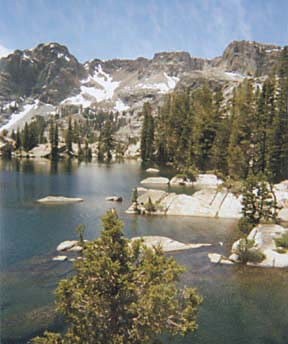 And the human interaction is wonderful. One sees a different side of California in towns like Tehachapi or Agua Dulce than one does on the coast. Eastern California's people are conservative, pleasant, generous and straightforward, closer in personality to Midwesterners than to the Angelenos with whom they share a state. And the human interaction is wonderful. One sees a different side of California in towns like Tehachapi or Agua Dulce than one does on the coast. Eastern California's people are conservative, pleasant, generous and straightforward, closer in personality to Midwesterners than to the Angelenos with whom they share a state.
This becomes most clear when you're hitchhiking. In areas dominated by urban residents out on vacation -- Angeles National Forest or Yosemite, for example -- it can take hours to get a ride. Some people scowl, others shrug, and some look like they're apologizing. A surprisingly large number wave happily at you from the cockpit of their enormous, empty SUVs and continue on their way. These people want to express their desire to pick you up without actually having to do so. Contrast that with the average rural resident: He or she will approach in a Ford pickup that's getting a little long in the tooth and either pick you up or ignore you and more often than not, they pick you up. Mountain people are like that, straightforward and honest. Sometimes they can be a little bit too honest. Hitching back out to the trail after spending a couple days in the Eastern Sierra community of Bridgeport, I was picked up by three young millworkers who were on their way back from an exciting evening at one of Nevada's fine uh, gentlemen's clubs. Suffice it to say that as the ride progressed, they shared a finer-grained picture of their adventures than I wanted to see. Half-way there My own adventure is only halfway done. Even as I write this, my backpack sits behind me on the floor of a friend's home here in Arcata. Tomorrow or the day after, I'll have to stuff the gear back in the bag, walk out to the highway, and start hitching back to the bustling community of Hat Creek, where I left the trail. I'll admit the idea is a little bit intimidating. It's nice to be back in a place where water comes out of a faucet and my conversations involve two parties. It's a cliché, but it's true: You never know what you've got until it's gone, and Arcata has never seemed so nice as it does today. But I know I'll go back soon. I see my reasons to leave everywhere I look: the telephone bills I don't have to pay any more, the traffic I'm never stuck in, the alarm clocks I don't ever have to set. The simplicity of the trail lifestyle has a very seductive call, at least after you get used to the blisters. After all, Canada isn't getting any closer with me just sitting here. Arno Holschuh was a staff writer for the North Coast Journal from
March 2000 through April 2002. After his trek he's moving to Berlin
to study the German alternative press on a Fulbright Fellowship.
Of calories, the Stones and bear repellent 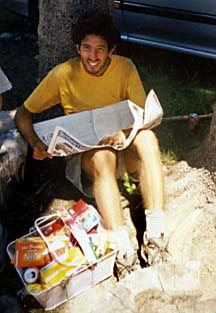 IT IS NATURAL TO ASSUME THAT A PERSON trying to complete a hike from one end of the country to the other would want as wholesome a diet as possible. Wrong. IT IS NATURAL TO ASSUME THAT A PERSON trying to complete a hike from one end of the country to the other would want as wholesome a diet as possible. Wrong.
Most thru-hikers, myself included, eat a diet that would make your doctor and dentist scream in horror: My staples are salty crackers, ramen, peanut M and Ms, Snickers bars and heavily sugared oatmeal. The foods may be high in fat and empty calories, but when you're hiking 30-mile days, calories are pretty much what you need. The only criteria that matter are how much a food weighs and how many calories it has, and I've long believed nothing has more calories per ounce than pure junk food. My belief in this dietary strategy was bolstered when I saw my friend and fellow hiker Mr. Bill stuffing an entire carton of Zingers into his backpack before leaving to tackle the Sierra. In real life, Bill works as a nutritionist. [At right, fellow thru-hiker stockpiles empty calories.] ^ ^ ^ Thru-hikers are obsessed with pack weight, plain and simple. When you're hiking all day, you kind of have to be, because the difference in physical condition and morale that 10 pounds can make is enormous. To that end, I carry a lightweight mummy sleeping bag, a tarp instead of a tent, rope and a cookstove that burns foul-smelling (but lightweight!) white tablets instead of gasoline. That, plus clothes, a cooking pot, food, water and some incidentals like a toothbrush, is it. Oh, and my one true luxury: a CD player/radio. Even though listening to those same eight CDs I brought is getting repetitive I think I know all the words to the Stones' "Exile on Main Street" by heart it helps to keep the motivation level high. And the pack is still pretty minimal: I haven't weighed it in a while, but my guess is that it can't be more than 20 pounds. ^ ^ ^ Every backpacker in California has to contend with the possibility of a wild bear encounter. Black bears are smart, strong, fast, persistent and hungry, and they have figured out that every human is a potential source of Oreos. And they love Oreos. Of course, so do I. And I carried the damn things on my back every day, so you can bet I'm going to try to defend them. I usually hang my food in a tree, although some bears have climbed high enough on the learning curve that this is no longer a safe way to protect food. Most thru-hikers try a simpler, more reckless approach: They use their food as a pillow. This has the advantage of being effective; bears do not relish human contact and will not usually try to take food right out of your hands. But if they ever did, the human would likely get a bit roughed up in the process; guarding your food is a pretty gutsy way to go. My favorite method is the "dirty sock" approach. Bears are reputed to hate the way humans smell. As you can imagine, after a few hundred miles and a few weeks, our socks start to get pretty ripe. Laundromats can be few and far between. It is not unusual to see a thru-hiker painstakingly arrange his dirty socks in a protective circle around his food bag in the hope that the bear would be so nauseated by the smell that he loses interest. After smelling some of the socks involved, I can assure you that they were enough to make me lose my appetite.
IN THE NEWS | IN THE GARDEN | CALENDAR Comments? E-mail the Journal: [email protected] 
© Copyright 2002, North Coast Journal, Inc. |